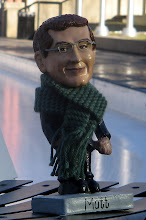 Last weekend I caught the final day of an exhibit of portraits by Latin American artists at the Bass Museum of Art, Retratos. The show includes this self-portrait by Frida Kahlo; from Miami it moves on to the National Portrait Gallery in Washington, D.C.
Last weekend I caught the final day of an exhibit of portraits by Latin American artists at the Bass Museum of Art, Retratos. The show includes this self-portrait by Frida Kahlo; from Miami it moves on to the National Portrait Gallery in Washington, D.C.It is not a huge exhibit - I was able to see the whole thing in less than an hour without feeling too hurried. The portraits seemed extremely thoughtfully and well chosen, though, demonstrating a wide range of artists, styles, and time periods without utterly overwhelming the visitor.
Among my favorites was Diego Rivera's 1946 "Elisa Saldívar de Gutiérrez Roldán". The dancer is elegantly framed by a green curtain and looks off with a curious and pensive gaze. I was struck by how a great portrait can capture so much about a person - not just by the costume and symbolic objects displaying her status, but the pose and facial expression which reveal her inner life. I found myself surrounded by intriguing characters like Elisa, none of whom I could ever hope to meet in person!
Many of the exhibit's most intriguing characters were the artists themselves, such as Lasar Segall, a Lithuanian-born Brazilian represented by "Autorretrato III." He stares suspiciously at the viewer while in the act of drawing, as though to underscore the ambivalent relationship of artist and audience. He seems anxious to protect his creation from our eyes, while at the same time his own gaze seems to strip us bare.
- - - - - -
I've been thinking about the conflicts of artists and their audiences quite a bit the past few days. This was partly inspired by a New Yorker article I read earlier this week about Ernest Hemingway, "Last Words" by Joan Didion. Hemingway instructed his survivors and publishers to destroy many of the letters and unpublished works he left behind at his death - nevertheless, those instructions were largely ignored. Didion writes:
The peculiarity of being a writer is that the entire enterprise involves the mortal humiliation of seeing one's own words in print. The risk of publication is the grave fact of life and, even among writers less inclined than Hemingway to construe words as the manifest expression of personal honor, the notion that words one has not risked publishing should be open to "continuing investigation" by "serious students of literature" could not be calculated to kindle enthusiasm.The same holds true of artists and composers - perhaps even bloggers, on occasion! Brahms exemplified the most extreme reaction against this kind of invasion, destroying practically all his sketches and correspondence just before his death. As curious listeners we mourn the loss of those artifacts; yet it seems somehow fitting for an artist who, as Michael Tilson Thomas told our orchestra this morning, always strove to express so much while keeping so much hidden.
- The New Yorker, November 9, 1988, p. 76-77
Keeping unfinished or unsatisfactory work hidden is much more difficult for artists in the Internet age - one recent example is Fiona Apple, as reported in The New Yorker and on NPR. Following a dispute with her producers at Sony, a preliminary version of her latest album Exraordinary Machine was circulated over the Internet. After hearing both versions, I think the official release is superior in many ways to the pirated album. Even were it not a great deal better, I think the artist deserves that her work be heard (and paid for!) as she intended.
Of course, one of the miracles of a work of art, no matter how carefully and intentionally created, is that once it leaves the artist's hand it takes on a life of its own. In many cases this is a truly beautiful thing - Diego Rivera probably never imagined the millions of souls his painting of Elisa would touch - while in others the unintended consequences are less gratifying. I wrote a post some time ago about an author I met named Robert Spirko, never thinking I might damage his career. A commenter today suggested that was exactly what I did, and so I want to offer Mr. Spirko my most sincere apologies.


 Technorati Link Count: no. of blog reactions to this post
Technorati Link Count: no. of blog reactions to this post
No comments:
Post a Comment